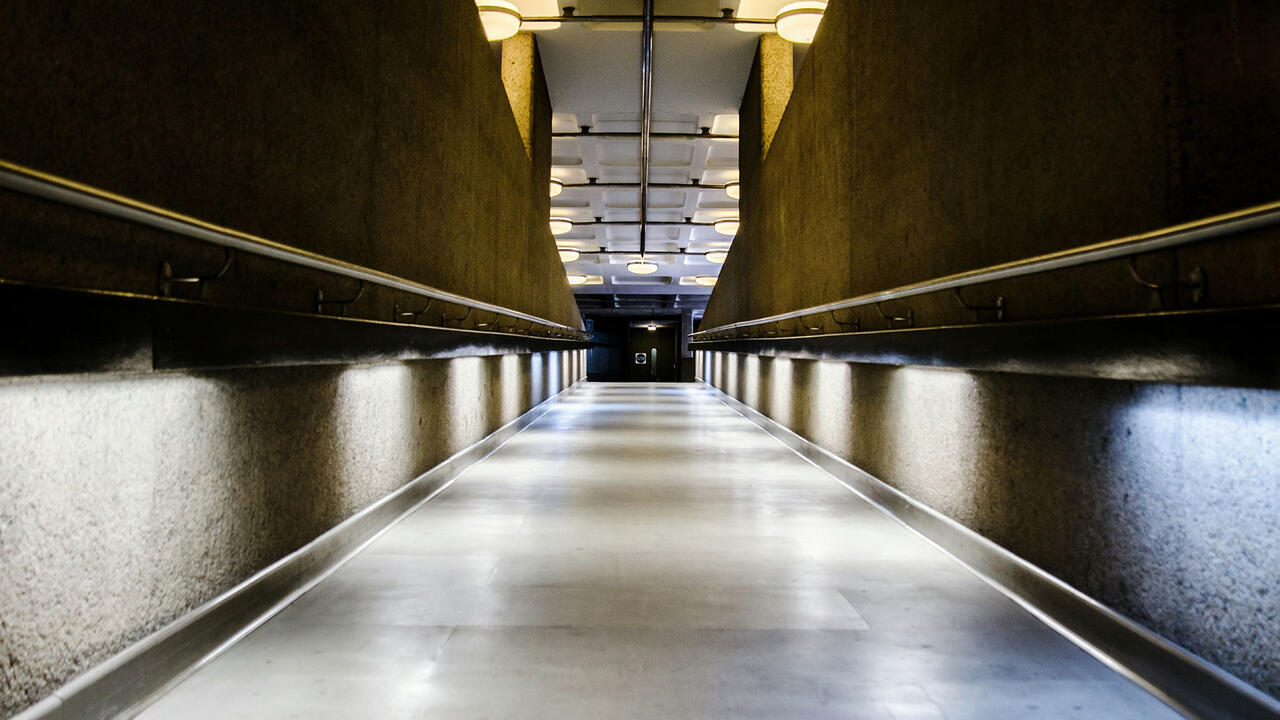The Garden of Good and Evil
Alfredo Jaar’s show at Yorkshire Sculpture Park, Wakefield, forces truth and images to confront each other
Alfredo Jaar’s show at Yorkshire Sculpture Park, Wakefield, forces truth and images to confront each other

On 9 October, the Guardian newspaper ran an interactive article exposing a series of declassified documents that extensively detailed the design and the condition of ‘black sites’ run by the CIA. Across the world – in Guantanamo Bay, Afghanistan, Romania, Thailand, among others – these facilities are used to brutally interrogate, detain and torture. Less than a week later, Yorkshire Sculpture Park unveiled a major new installation by Alfredo Jaar, The Garden of Good and Evil (2017), as part of the artist’s current solo exhibition. For Jaar, who refers to himself as a ‘frustrated journalist’, The Garden of Good and Evil is the culmination of his research into black sites: landscapes of extreme physical and political injustice. The garden is comprised of 101 evergreen trees in simple wooden planters. Nine steel cells are obscured within the grove. Jaar infuses mathematical rigour, each of the planters and the cells all measure one square metre, with evocative poeticism: the size inspired by Palestinian exile Mahmoud Darwish’s poem ‘One Square Metre of Prison’. The cold, objective rationality of minimalism is combined with a quiet, subjective urgency. Human presence is imperative. The viewer is implicated in their act of witnessing, encouraged to explore the grove in order to find the hidden cells. This element of discovery will perhaps be realized most effectively when the installation is planted in YSP’s grounds after the exhibition closes in 2018.

The oscillation between poignancy and precision, the artist and the architect, is clear in A Hundred Times Nguyen (1994), which Jaar created in response to the mass incarceration of Vietnamese refugees in Hong Kong detention centres in the early 1990s. Despite taking 1,378 photographs while in Hong Kong, Jaar focuses on one individual, a young girl, Nguyen Thi Thuy, in order to convey the scale of oppression. Four photographs of Nguyen facing the camera, her emotions moving from candid to self aware, are rearranged in 24 different sequences, and also appear in book form and on a rolling video channel. A Hundred Times Nguyen short-circuits the constant assault of violent images that often dominate mainstream media.

Jaar is motivated by the desire to convey ideas through visual information. His unique visual language is challenging, producing active images that speak and demand to be read. This is particularly apposite in the controlled viewing environment created for the eight-minute film The Sound of Silence (2006). A small theatre space – the exterior walls covered in almost-blinding LED light strips – has been built to tell the story of a single image. Due to the chronology of the film sequence, the viewer can only enter when a green light illuminates. A silent projection of rolling text tells the story of Kevin Carter’s infamous ‘Starving Child and Vulture’ photograph, which was taken during the 1993 Sudan famine. The narrative wrestles with ideas of suffering, grief, and ethical responsibility. We only see Carter’s image for a fraction of second; first we are startled and objectified by the unexpected flashing of multiple cameras installed next to the screen, before it appears. In an age in which we are overwhelmed with ambiguous images, the experience, so explicit, so exacting, is winding.

In Shadows (2014), which follows The Sound of Silence in an ongoing trilogy, Jaar introduces his audience to another harrowing photographic series. In a dark viewing space, Jaar has installed seven light boxes, each of which show a photograph from a series taken by the Dutch photojournalist Koen Wessing in 1978 in Esteli, Nicaragua. Jaar’s selection tells the narrative of two daughters’ reaction to their father’s murder by Nicaraguan National Guardsmen. This metaphorical and literal illumination, this specific focus, is explored more conceptually in the adjacent space. The photograph of the daughters performing a wild, expressive dance of grief is blown up into a large-scale projection. The image slowly fades, gradually reduced into the outline of their two bodies, finally melting into a cut out of searing white-hot light.

When Jaar does use words, he borrows them from other sources. Visitors are encouraged to take a large poster away with them, emblazoned with the phrase ‘YOU DO NOT TAKE A PHOTOGRAPH, YOU MAKE IT.’ Jaar calls for greater consciousness and responsibility, reminding us that the perceived veracity of images needs to be interrogated. Two neon text works also bookend the exhibition - I Can't Go On I'll Go On (2016) and Be Afraid of the Enormity of the Possible (2015), borrowed from Samuel Beckett and Romanian writer Emil Cioran respectively. The quotes encourage a form of pessimism as passion, forging solidarity, resilience and wilful optimism. Jaar forces us to see, to confront, and to try to understand.
Main image: Alfredo Jaar, The Garden of Good and Evil, 2017, installation view, Yorkshire Sculpture Park, Wakefield. Courtesy: the artist, a/political, London and Yorkshire Sculpture Park, Wakefield; ; photograph: © Jonty Wilde





















